
Service hotline:
13533607738
18602592233
Welcome to 广东脊祥万岁健康管理有限公司!
最新资讯
The most basic thing we should all know is that there is an important body part in this link: the pelvis.
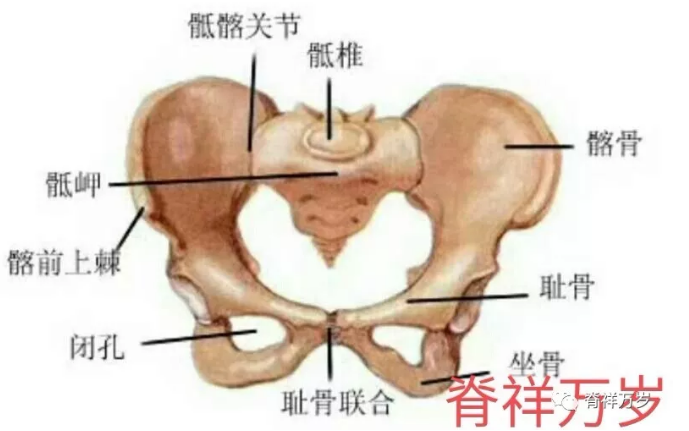
There are many problems of pelvic deviation. Today Professor Ye Huiyang will talk about several problems of pelvic deviation and how to adjust and alleviate them.
Anatomically, the pelvis consists of the sacrum, the coccyx and the left and right hip bones. Each hip bone is fused with the ilium, the ischium and the pubis. Of course, there are also pelvic joints, pelvic ligaments, I will not go into details here.
Female pelvis is the bony connection between the trunk and lower limbs, an important organ to support the trunk and protect pelvic organs, and a necessary bone birth canal for the fetus during childbirth. Its size and shape directly affect the delivery process. Usually female pelvis is wider and shallower than male pelvis, which is conducive to fetal delivery.
Not to elaborate on the anatomical content, but also tired to watch. Professor Ye will talk about pelvic problems.
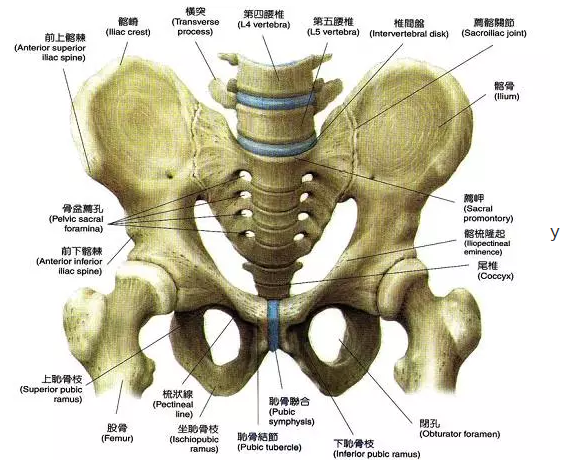
The common pelvic troubles are pelvic "skew". The skeleton itself is not deformed because of the unbalanced muscles (except for special physiological problems or accidents, so the following are all about eliminating such special events). Professor Ye will talk about the following points today:
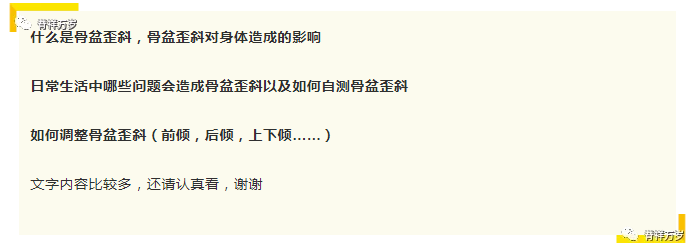

What we usually say about pelvic deviation is more about a change in angle. It means that the skeleton itself does not deform, but it looks askew. Wechat Public Platform: Vertebral Health Alliance
For example, if you stand with one leg exerted and one leg relaxed, you will find that the "appearance" of the pelvic shape will change with a slight change of posture. This change is not because the pelvic structure is skewed, but because the muscular movements change the position of the pelvis, resulting in the visual appearance of the pelvis as skewed.
Because the body is moving at any time and anywhere, so the muscles will continue to contract and relax repeatedly. In muscle activity, if a problem occurs somewhere that prevents the pelvis from returning to its original position, it becomes hardened, which is called "pelvic deviation". It's like the feeling that a stretch rope can't return to its original state because of overuse.
The pelvic deviation is actually the continuous tightening of the muscles associated with pelvic movements, which results in a slightly skewed appearance, rather than the structural distortion of the hip, sacrum and coccyx that make up the pelvis. So as long as the condition of excessive muscle tension or relaxation is improved, the skewed situation will naturally improve.
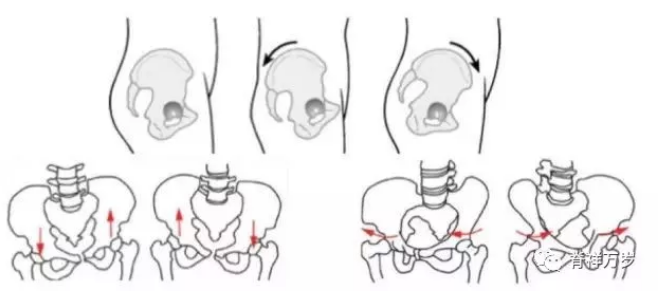
Let's take a look at the physical problems caused by pelvic deviation.
External issues:
Hump-backed, buttocks drooping, O-legs and X-legs (inner octagonal legs), obesity
Internal problems:
Shoulder and neck stiffness, low back pain, physical pain, cold system
Is there a familiar feeling that you find yourself with one or more of these problems?
Of course, besides pelvic deviation, there is pelvic relaxation (next time)
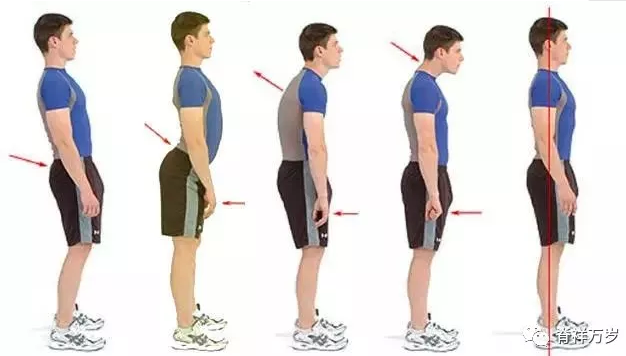

As mentioned earlier, pelvic deviation is caused by muscle tension, so most people with pelvic deviation problems may be improper use of muscles.
Take walking as an example, everyone's weight distribution, foot landing methods have their own habits, I often see someone's shoes grinding "each has its own merits" ah, walking posture is also. Of course, many unconscious behaviors and habits in daily life can also cause pelvic deviation.
Here Professor Ye lists some common questions:
1. Like to cross Erlang's legs
2. Often carry one shoulder bag, and like to carry only one shoulder.
3. When sitting, one side of the buttock is used to exerting, or fails to reach the bottom, but likes to lean on the back of the chair.
4. Sitting incorrectly for a long time (crooked, hunched, etc.)
5. Wear high heels for a long time and pose incorrectly
6. Sprains and injuries did not heal
7. Congenital type O legs, flat feet, plus overweight, overexercise
8. Weak abdominal and dorsal muscles
9. Delivery (For women who have had babies, the pelvic movable area is larger than before, and if proper postpartum repair is not added, it will have a greater impact on the future).
Do you think you have a lot of recruits at once?
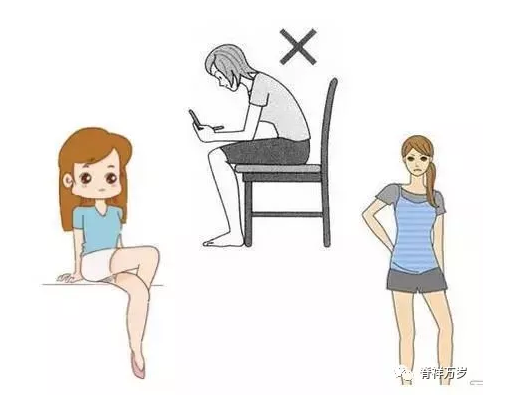
So how do you check if your pelvis is skewed?
Come on, let's look at it in these simple ways.
1. Length of the left and right feet varies when the feet are stretched (or look at your trousers'feet for yourself, which wears badly)
2. Uneven wear of soles
3. The height of the left and right shoulders is different.
4. Different heights of pelvis (waist, ilium)
5. When you hold your knees, the center of your knees is not in the center of your body.
6. When you hold your knees, the height of your left and right knees is different.
7. When lying horizontally, the angle of the toes varies from left to right.
8. When wearing clothes, one side of the left and right is easily displaced (for example, in a skirt, the skirt always turns in one direction).
9. When hands are raised, the left and right heights are different.
10. When sitting with the soles of the feet merged, the height of the left and right knees is different...
Have you checked it out? Are there any problems? Did you find it from the above daily posture problems?
Don't panic, these are simple self-tests, more specific tests need professional teachers to evaluate.

The primary goal of pelvic adjustment is to restore pelvic muscle flexibility and enhance contractility, thereby eliminating pelvic tilt and relaxation that cause various discomfort symptoms.
Not only the muscles around the pelvis, but also all the muscles must "contract back to their original state" in order to really exert their movements and strength. If the weakness of the muscles can not fully contract or become rigid and lose their contractility, besides the muscles themselves can not properly move, it will also hinder the other muscles jointly exercising and cause skewed conditions.
In order to avoid this situation, it is very important to strengthen weakened muscles, relax stiff muscles, and use stretching to restore the original flexibility of muscles. So we need to adjust through the following three parts or steps.
Relaxation: Relaxation can alleviate excessively tense muscles, restore the muscles to their original state, promote blood circulation, and raise the temperature of muscles. Therefore, it is suggested that before starting other exercises, relaxation should be carried out to improve the overall effect of exercises.
Intensification: Intensification is to improve muscle contraction, so that the muscle back to the appropriate contraction state, in order to play its due function when needed.
Stretching: Stretching restores the muscle to its original softness and helps the blood flow back to its normal state.
Now, let's classify the specific deviations of the pelvis and discuss how to adjust them.
Pelvic anteversion
This type can be divided into two types: the "excessive protrusion and backward warping" type and the "postpartum, age-increasing" type.
1. Overprotruding and backward warping
Main features: protruding chest and buttocks, at first glance, wow, the lines are beautiful, protruding and protruding, but in fact her abdominal muscles are in a weak state, the pelvis is seriously forward, such people do slightly backward bending movements will be uncomfortable, easy to waist pain, it is easy to think that the waist problems to check.
Muscle condition: Abdominal, gluteal and parapopliteal muscles are very weak; iliopsoas and back are very hard;
Specific analysis: The protrusion of the lower abdomen is due to the weakening of the transverse abdominal muscle, which causes the abdomen unable to retract inward. The transverse abdominal muscle is the muscle that exerts pressure on the abdomen. It strengthens the abdominal pressure and restores the pelvis to the correct position. In addition, in addition to the transverse abdomen muscle, buttock muscle, popliteal muscle is also weak, so it must be strengthened together. It is generally believed that the cause of anteversion may be the stiffness of iliopsoas muscle, the continuous maintenance of contraction, or the continuous tightening and contraction of the waist. Therefore, it is necessary to relax and extend the iliopsoas muscle and the waist.
Main Directions: Relax hip joint, back and body side, pelvis, strengthen abdominal muscle, stretch waist and iliopsoas muscle
2. Postpartum, age-increasing type
Main characteristics: Because of childbirth and age, these people are prone to extreme weakness of abdominal muscles. When the strength of the abdominal muscles is weak, the lower abdomen will protrude. In order to hide the lower abdomen, it is easy to hunch.
Muscle condition: weakness of abdominal and iliopsoas muscles, stiffness of lumbar and parapopliteal muscles
Specific analysis: This type of person, like the previous type of person, has a protruding abdomen, so it is necessary to strengthen the abdominal muscles, so that the pelvis can maintain its original upright state. And they have hunchbacks, so they have to relax and stretch the whole back to restore flexibility, while strengthening the iliopsoas muscle to help maintain pelvic stability and not tilt.